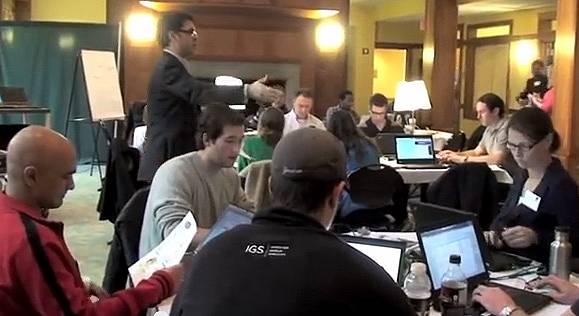Tuck Students Participate in World Premier of Big Data Simulation
Students use data to assess performance and diagnose problems.

A dynamic data environment provided second-year MBA students a glimpse of cutting edge analytic technology.
On a recent Thursday afternoon at Tuck, teams of four or five second-year students sat at tables and imagined they were managing competing German wholesale dairy-product companies. On their laptops they looked at spreadsheets of data on the six products in the market, including prices, orders, stock levels, cash flow, and profits. Their task was to use a unique analytics tool from enterprise software company SAP to understand how the variables interact, and make the ordering and pricing decisions that would return maximum profits.
The key to HANA is its ability to compress data onto a solid-state drive so that large amounts of information can be accessed and processed instantaneously."
“HANA can crunch much more data at once and provide much more insight to managers,” Léger said, “and this game is really about having the students experience, in the classroom, the challenge and opportunity of big data.”
For Alva Taylor, the faculty director of Tuck’s Glassmeyer/McNamee Center For Digital Strategies, which helped organize the simulation, the main challenge of big data is figuring out how to use it. “Too much information can actually be detrimental to managerial decision making,” Taylor said. “Successful companies will use tools like HANA to avoid getting overwhelmed and to sidestep decision traps that can arise when using dense data. What’s great about this simulation is that Tuck students will have hands-on experience with cutting-edge technology so they can use it strategically when they return to the business world.”
Managers use HANA today like Billy Beane, the general manager of the Oakland Athletics, uses sabermetrics: to gain an accurate picture of the market and make the decisions that directly impact success. In Beane’s case, it means hiring the right baseball players. For corporate managers, it can mean something as simple as keeping hot products in stock, by tracking sales and inventory of SKUs in real-time. “Managers are looking at HANA every hour,” said John Baxter T’88, who leads the SAP University Alliances program in the eastern U.S., “and adjusting their strategies on the spot. Increasingly, executives are drilling down into this data to assess performance and diagnose problems.”
After the first 20 minutes, the teams of students had experienced an accelerated business quarter and could get an initial sense of how their analytics strategies were working. Had they set prices too low and received too many orders? Did they fall prey to market aberrations? As in life, there were winners and losers, and valuable lessons. Unlike the real world, however, no one got fired for messing up.